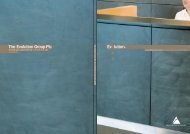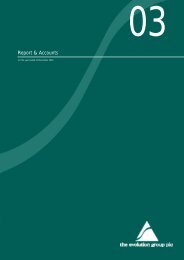Annual Report for the year ended 31 December 2008
Annual Report for the year ended 31 December 2008
Annual Report for the year ended 31 December 2008
Create successful ePaper yourself
Turn your PDF publications into a flip-book with our unique Google optimized e-Paper software.
1. aCCoUntinG PoliCies (CONTINuED)<br />
These may include comparison to similar instruments where market<br />
observable prices exist, discounted cash flow analysis, option pricing models<br />
such as Black-scholes and o<strong>the</strong>r valuation techniques commonly used by<br />
market participants.<br />
The Group makes an assessment at each Balance sheet date as to whe<strong>the</strong>r<br />
<strong>the</strong>re is any objective evidence of impairment, being any circumstance<br />
where an adverse impact on estimated future cash flows of <strong>the</strong> financial<br />
asset or group of assets can be reliably estimated. in <strong>the</strong> case of equity<br />
investments classified as available-<strong>for</strong>-sale, <strong>the</strong> cumulative loss (measured<br />
as <strong>the</strong> difference between <strong>the</strong> acquisition cost and <strong>the</strong> current fair value,<br />
less any impairment loss on that financial asset previously recognised in<br />
<strong>the</strong> income statement) is removed from equity and recognised in <strong>the</strong><br />
income statement. impairment losses recognised in <strong>the</strong> income statement<br />
on available-<strong>for</strong>-sale equity investments are not reversed through <strong>the</strong><br />
income statement.<br />
Derivative financial instruments<br />
Derivative contracts relating to equity options and warrants held have been<br />
acquired at zero cost in lieu of corporate finance fees. WDB capital uK equity<br />
Fund limited holds contracts <strong>for</strong> difference (“cFD”) and <strong>the</strong>se are brought<br />
into <strong>the</strong> Group on consolidation. Derivatives are initially accounted <strong>for</strong> and<br />
measured at fair value on <strong>the</strong> date a derivative contract is entered into and<br />
subsequently measured at fair value. The gain or loss on re-measurement is<br />
taken to <strong>the</strong> income statement within trading income. Fair values are obtained<br />
from quoted prices prevailing in active markets, including recent market<br />
transactions, and valuation techniques, including discounted cash flow models<br />
and options pricing models as appropriate. All derivatives are included in<br />
assets when <strong>the</strong>ir fair value is positive and liabilities when <strong>the</strong>ir fair value is<br />
negative, unless <strong>the</strong>re is <strong>the</strong> legal ability and intention to settle net.<br />
The regular way purchase or sale of held <strong>for</strong> trading financial assets is recognised<br />
using trade date accounting. A regular way purchase or sale is a purchase or<br />
sale of a financial asset under a contract whose terms require delivery of <strong>the</strong><br />
asset within <strong>the</strong> time frames established generally by regulation or convention<br />
in <strong>the</strong> marketplace concerned. purchases or sales that do not fall within <strong>the</strong><br />
regular way classification (generally beyond three days settlement) are treated<br />
as derivatives in <strong>the</strong> period between <strong>the</strong> trade date and <strong>the</strong> settlement date,<br />
i.e. as a <strong>for</strong>ward purchase or sale of security. The contract value (i.e. <strong>the</strong> trade<br />
date receivable or payable) of such transactions is not recorded on <strong>the</strong><br />
Balance sheet, but <strong>the</strong> change in fair value is recognised on <strong>the</strong> Balance<br />
sheet and income statement within trading income in <strong>the</strong> intervening period<br />
between <strong>the</strong> trade date and settlement date.<br />
Stock borrowing and lending<br />
The Group enters into stock borrowing and lending arrangements with<br />
certain institutions on a collateralised basis with securities or cash advanced<br />
or received as collateral. The transfer of securities to institutions is not<br />
reflected on <strong>the</strong> Balance sheet. Where cash collateral is advanced or<br />
received, an asset or liability is recorded at <strong>the</strong> amount of cash collateral<br />
advanced or received. securities borrowed are recognised on <strong>the</strong> Balance<br />
sheet and are recorded as a trading liability and measured at fair value.<br />
Fees charged in <strong>the</strong> course of borrowing are recorded on an accruals basis<br />
and included within o<strong>the</strong>r operating expenses. interest received or paid on<br />
collateral is included within finance income or expense.<br />
notes to tHe FinanCial statements CONTINuED<br />
FOR THE YEAR ENDED <strong>31</strong> DECEMBER <strong>2008</strong><br />
48 The evoluTion Group plc AnnuAl reporT & AccounTs <strong>2008</strong><br />
Trade and o<strong>the</strong>r receivables<br />
Trade and o<strong>the</strong>r receivables (which include counterparty receivables) are<br />
recognised initially at fair value and subsequently measured at amortised cost<br />
using <strong>the</strong> effective interest method, less provision <strong>for</strong> impairment. A provision<br />
<strong>for</strong> impairment of trade receivables is established when <strong>the</strong>re is objective<br />
evidence that <strong>the</strong> Group will not be able to collect all amounts due according to<br />
<strong>the</strong> original terms of <strong>the</strong> receivables. evidence that an impairment of <strong>the</strong> asset<br />
may be required includes ageing of <strong>the</strong> debt beyond 180 days, persistent<br />
lack of communication and internal awareness of third party trading difficulties.<br />
The amount of <strong>the</strong> provision is <strong>the</strong> difference between <strong>the</strong> asset’s carrying<br />
amount and <strong>the</strong> present value of estimated future cash flows, discounted at<br />
<strong>the</strong> effective interest rate. The amount of <strong>the</strong> provision is recognised in <strong>the</strong><br />
income statement within operating expenses.<br />
Cash and cash equivalents<br />
For <strong>the</strong> purposes of <strong>the</strong> cash flow statement, cash and cash equivalents<br />
include cash in hand, deposits held at call with banks, and o<strong>the</strong>r short-term<br />
highly liquid investments that are readily convertible to known amounts of cash<br />
and which are subject to an insignificant risk of change in value. such investments<br />
are normally those with original maturities of three months or less.<br />
Trade and o<strong>the</strong>r payables<br />
Trade and o<strong>the</strong>r payables (which includes counterparty payables) are<br />
recognised initially at fair value, which is <strong>the</strong> agreed market price at <strong>the</strong><br />
time goods or services are provided and are subsequently recorded at<br />
amortised cost using <strong>the</strong> effective interest rate. The Group accrues <strong>for</strong> all<br />
goods and services consumed but as yet unbilled at amounts representing<br />
management’s best estimate of fair value.<br />
Provisions<br />
provisions are recognised <strong>for</strong> present obligations arising as consequences<br />
of past events where it is probable that a transfer of economic benefit will<br />
be necessary to settle <strong>the</strong> obligation and it can be reliably estimated.<br />
provisions <strong>for</strong> dilapidation on leasehold premises are recognised as a liability<br />
in all <strong>year</strong>s over <strong>the</strong> life of <strong>the</strong> lease and discounted to fair value at an<br />
effective interest rate over <strong>the</strong> period of <strong>the</strong> property lease. The accrual is<br />
based on expected costs to be incurred at <strong>the</strong> end of <strong>the</strong> lease period to<br />
bring <strong>the</strong> building back into a suitable state discounted to <strong>the</strong> net present<br />
value using an effective discount rate that reliably calculates <strong>the</strong> present<br />
value of <strong>the</strong> future obligation.<br />
contingent liabilities are possible obligations whose existence will be<br />
confirmed only by uncertain future events or present obligations where <strong>the</strong><br />
transfer of economic benefit is uncertain or cannot be reliably measured.<br />
contingent liabilities are not recognised in <strong>the</strong> Financial statements,<br />
however, <strong>the</strong>y are disclosed unless considered remote.<br />
Employee benefits<br />
(a) Pension obligations<br />
The Group does not offer any company pension schemes. however, <strong>the</strong><br />
Group does make defined contributions to employees’ approved personal<br />
pension plans, and <strong>the</strong> costs of <strong>the</strong>se are charged to <strong>the</strong> income statement<br />
when <strong>the</strong>y are incurred.


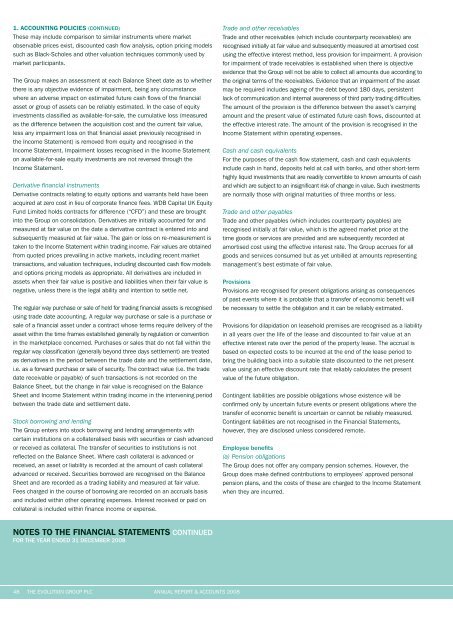
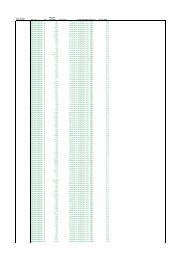
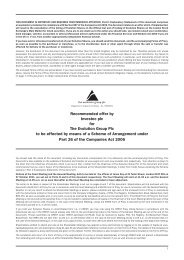

![2. Front continued [c87307] - The Evolution Group PLC](https://img.yumpu.com/19604468/1/184x260/2-front-continued-c87307-the-evolution-group-plc.jpg?quality=85)
